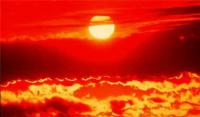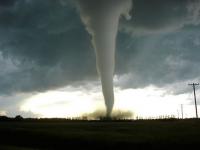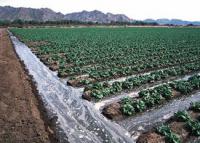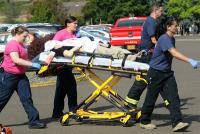-
What do climate tipping points mean for society
The phrase “tipping point” passed its own tipping point and caught fire after author Malcolm Gladwell’s so-named 2000 book. It is now frequently used in discussions about climate change, but what are “climate tipping points”? And what do they mean for society and the economy? In a new study, scientists tackle the terminology and outline a strategy for investigating the consequences of climate tipping points. The authors recommend using the phrase “climatic tipping elements” to describe portions of the climate system that may be abruptly committed to major shifts as a result of the changing climate.
-
-
DHS S&T demonstrates integration of first responder technologies
More ruggedized protective equipment. Reliable and interoperable communications. The capability to filter vast amounts of data. These are all things DHS Science and Technology Directorate (S&T) Next Generation First Responder (NGFR) program envisions to ensure future first responder are better protected, connected, and fully aware.
-
-
Roundup of spring, summer 2016 First Responders Group technology
The DHS S&T regularly posts a roundup of key updates from projects currently in the development stages in S&T’s First Responders Group (FRG). S&T the other day offered an outline of FRG’s accomplishments in April, May, and June.
-
-
Assessing climate change risks to U.K.
Climate change is happening now. Globally, 14 of the 15 hottest years on record have occurred since 2000. The impacts of climate change are already being felt in the United Kingdom, and urgent action is required to address climate-related risks, the Committee on Climate Change’s (CCC)’s Adaptation Sub-Committee (ASC) said the other day.
-
-
100s of deaths in two cities in 2003 heatwave due to man-made climate change: Scientists

Scientists have specified how many deaths can be attributed to man-made climate change during an extreme heatwave in two European cities in 2003. The study says that with climate change projected to increase the frequency and severity of future heatwaves, these results highlight an emerging trend. The authors suggest that such research gives policymakers better information about the damaging effects of heatwaves to help them respond to the future challenges of climate change.
-
-
Super-sniffer mice detect land mines, decode human olfactory system

Researchers have created super-sniffer mice that have an increased ability to detect a specific odor. The mice, which can be tuned to have different levels of sensitivity to any smell by using mouse or human odor receptors, could be used as land-mine detectors or as the basis for novel disease sensors.
-
-
U.S. suffered at least $8 billion climate-related disasters so far this year

We are only halfway through 2016 and the United States has already seen eight weather and climate-related disasters* that have each met or exceeded $1 billion in damages. These eight disasters resulted in the loss of thirty lives, and caused at least $13.1 billion. Since 1980 the United States has sustained 196 weather and climate disasters in which overall damages/costs reached or exceeded $1 billion. The total cost of these 196 events exceeds $1.1 trillion.
-
-
June was the warmest on record for contiguous U.S.
Summer is off to a sizzling start. The average June temperature for the Lower 48 states was 71.8 degrees F, making it the warmest June on record. Above-average temperatures spanned the nation from coast to coast, and seventeen states across the West, Great Plains, and parts of the Southeast experienced temperatures much above average. June precipitation for the contiguous U.S. averaged 2.46 inches, 0.47 inch below average, ranking as the fourteenth driest on record.
-
-
Better soil data is key for future food security

To project how much food can be produced in the future, researchers use agricultural models that estimate crop yield, or how much of a crop can be produced in a certain amount of space. These models take into account factors like climate and weather variability, irrigation, fertilizer, and soil type. A new study shows that the type of soil used in such a model can often outweigh the effects of weather variability — such as year-to-year changes in rainfall and temperature.
-
-
DHS announces the Countering Violent Extremism grant program
Secretary of Homeland Security Jeh Johnson on Wednesday announced the Fiscal Year (FY) 2016 Countering Violent Extremism (CVE) Grant Program, with $10 million in available funds. DHS snotes that this is the first federal assistance program devoted exclusively to providing local communities with the resources to counter violent extremism in the homeland.
-
-
Can next-generation bomb ‘sniffing’ technology outdo dogs on explosives detection?
With each terrorist attack on another airport, train station, or other public space, the urgency to find new ways to detect bombs before they’re detonated ratchets up. What researchers have wanted to develop for a long time is a new chemical detection technology that could “sniff” for explosives vapor, much like a canine does. Many efforts over the years fell short as not being sensitive enough. My research team has been working on this problem for nearly two decades – and we’re making good headway. Inspired by the tremendous detection capabilities of dogs, we’ve made remarkable advances toward developing technology that can follow in their footsteps. Deploying vapor analysis for explosives can both enhance security levels and provide a less intrusive screening environment. Continuing research aims to hone the technology and lower its costs so it can be deployed at an airport near you.
-
-
Electronic nose detects pesticides, nerve gas
Detecting pesticides and nerve gas in very low concentrations? An international team of researchers has made it possible. The researchers have built a very sensitive electronic nose with metal-organic frameworks (MOFs). The chemical sensor can easily be integrated into existing electronic devices.
-
-
Applying public health models to gun violence

Research treats shootings like an epidemic — by applying public health models. Data indicate an individual’s odds of being a gunshot victim increase with exposure to gun violence. The work focuses not on mass shootings or isolated incidents of violence – rather, the researchers have worked to gather data on populations that face persistent threats of gun-related attacks and homicides, often connected to gang and drug activity.
-
-
Huge helium discovery in Tanzania is “a life-saving find”
Helium does not just make your voice squeaky — it is critical to many things we take for granted, including MRI scanners in medicine, welding, industrial leak detection, and nuclear energy. However, known reserves are quickly running out. Until now helium has never been found intentionally — being accidentally discovered in small quantities during oil and gas drilling. Researchers have developed a new exploration approach, and the first use of this method has resulted in the discovery of a world-class helium gas field in Tanzania.
-
-
Thirty-one leading scientific societies call for action on climate change
In a consensus letter to U.S. policymakers, a partnership of thirty-one leading nonpartisan scientific societies the other day reaffirmed the reality of human-caused climate change, noting that greenhouse gas emissions “must be substantially reduced” to minimize negative impacts on the global economy, natural resources, and human health. Climate-change impacts in the United States have already included increased threats of extreme weather events, sea-level rise, water scarcity, heat waves, wildfires, and disturbances to ecosystems and animals, the intersociety group reported.
-
More headlines
The long view
Encryption Breakthrough Lays Groundwork for Privacy-Preserving AI Models
In an era where data privacy concerns loom large, a new approach in artificial intelligence (AI) could reshape how sensitive information is processed. New AI framework enables secure neural network computation without sacrificing accuracy.
AI-Controlled Fighter Jets May Be Closer Than We Think — and Would Change the Face of Warfare
Could we be on the verge of an era where fighter jets take flight without pilots – and are controlled by artificial intelligence (AI)? US R Adm Michael Donnelly recently said that an upcoming combat jet could be the navy’s last one with a pilot in the cockpit.
The Potential Impact of Seabed Mining on Critical Mineral Supply Chains and Global Geopolitics
The potential emergence of a seabed mining industry has important ramifications for the diversification of critical mineral supply chains, revenues for developing nations with substantial terrestrial mining sectors, and global geopolitics.
AI and the Future of the U.S. Electric Grid
Despite its age, the U.S. electric grid remains one of the great workhorses of modern life. Whether it can maintain that performance over the next few years may determine how well the U.S. competes in an AI-driven world.
Using Liquid Air for Grid-Scale Energy Storage
New research finds liquid air energy storage could be the lowest-cost option for ensuring a continuous power supply on a future grid dominated by carbon-free but intermittent sources of electricity.
Enhanced Geothermal Systems: A Promising Source of Round-the-Clock Energy
With its capacity to provide 24/7 power, many are warming up to the prospect of geothermal energy. Scientists are currently working to advance human-made reservoirs in Earth’s deep subsurface to stimulate the activity that exists within natural geothermal systems.
